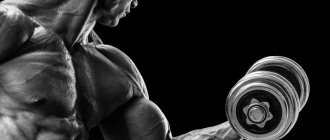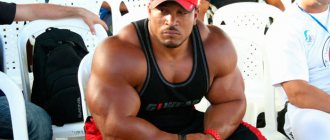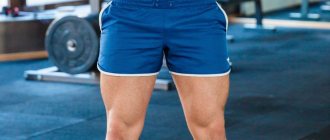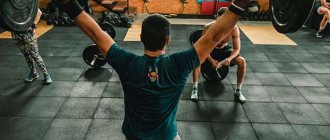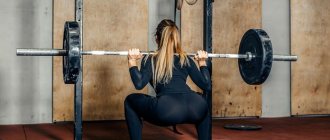To become strong and build muscle, you don't have to exercise often. Let's consider the option of low-volume, high-intensity training.
In recent years, I have often come across the opinion that strength training in the gym should be frequent. It would seem, why not? After all, quantity develops into quality?
Of course, basic exercises like squats, deadlifts, and bench presses can be performed frequently, and many do. Many have tried wave periodization of loads by day, when the same high-intensity exercises are performed 2-4 times a week, or even more often. Some saw good results and rushed to praise this approach online. But they soon found themselves at a dead end.
Why? Because for powerlifters it is often important to force themselves to slow down, not the other way around.
This prompted me to develop programs with reduced volume and frequency, conducting 3 workouts per week, alternating loads on the upper and lower body. Also, I suggest not performing back squats and deadlifts in the same week.
Yes, yes, that's not a typo. Let's figure it out.
Russian Influence
I will not flood this article with links to 20-week studies conducted on college students. I will simply refer to a recent study with a suitable design, according to which wave periodization by days has no advantage over classical linear periodization.
The effectiveness of a training program depends to a great extent on how much the athlete commits to it and how much it matches his spirit. This cannot be calculated in the laboratory. The variables that make a program effective are often intangible; they lie in the personality of the practitioner.
At one time I made training progress by doing small amounts of high-intensity work. It was in my spirit.
When I started powerlifting, I heard that this approach wouldn't work, that you had to lift heavy weights often. Large volumes, many times a week. This vision was based on the programs used by Russian powerlifters.
Well, I tried it out. And I hated it. It didn't resonate with me and I disliked the training.
I was struggling with how to create a training program that could combine my love of low volume with high intensity. At least just for powerlifting. I read a lot, but did not find anything that would give me faith.
Finally, I put aside reading and did what I should have done a long time ago - I learned everything on my own.
Squats and Deadlifts Every Week
When I developed my technique, the Internet was still in its infancy. This is one of the reasons I couldn't find enough information on how to develop strength abilities without the volume and frequency used in most programs.
But I did know that squats and deadlifts work the muscles in the back of the body, and if you spread these exercises over different weeks, then although the same muscle groups would be worked each week, a significant portion of the load would fall on different areas - e.g. knee extensors or chest extensors.
Of course, the quadriceps are active during the deadlift, but the knee extension is minimal. This means, I reasoned, that on the days of performing deadlifts it is necessary to place additional load on the leg muscles. But I wanted to make sure that this load would not overload the back muscles: many powerlifters do not know that erectors recover very slowly, and it is this under-recovery that most often slows down progress.
In other words, squats and deadlifts are usually sufficient to stimulate growth in the size and strength of the erectors of the back. Additionally, all you need is quality rest. After conscientiously doing leg presses and shin curls in the machine, torturing yourself with repeated hyperextensions and good mornings is unnecessary and, in general, useless.
NeuroNation
An interesting course with interestingly illustrated tasks that are more like a game. Gamification of training encourages greater engagement for maximum effectiveness.
At the beginning of the training, you will be asked to answer 11 questions that will allow you to build a personalized training plan that matches your goals and current level of performance.
Preparatory tasks to assess your level of working memory control are provided free of charge.
By the way, there is also a Russian analogue - the Vikium service.
Auxiliary Exercises
How can you ensure that squats and deadlifts fully engage the target muscle groups? Obviously, it is wise to combine them with additional exercises.
As for complementing the deadlift, I personally settled on the leg press, since it is a good load on the quadriceps, and, due to the truncated range of motion, it is gentle on the lower back. At the same time, the amplitude is still close to full, which means that you do not need to load the machine with all the weights in the gym in order to achieve muscle fatigue.
In my experience, the leg press is also an exercise that helps you learn to push off the floor. After all, many do not understand that performing a deadlift means not just pulling the barbell, but pushing off from the support and moving the weight above the knee line.
Regarding squats, I wanted to make sure that on the days when they were performed, the load still fell on the back muscles, which performed the lion's share of the work when performing deadlifts.
And I chose the bent over row. In a sense, this is a lighter version of the deadlift: the lower back also works in an isometric mode, holding the body. In addition, I would recommend periodically supplementing squats with rows of a vertical block to the chest. And on deadlift days, after leg presses, sometimes do another “exhaustive” set of squats in the hack squat machine. Such additions gave me a feeling of completeness of the training.
Advice for conscripts
A number of tricks will help you build up your muscles and not lose shape in the harsh everyday life of the army:
- Don't skip meals. Breakfast, lunch and dinner strictly on schedule will provide you with energy for training, and your muscles with building material for growth.
- Try to establish contact with the army environment. Friendship with the cook will allow you to receive additional portions of food, and finding a common language with senior officers will facilitate unhindered access to the gym.
- Make the most of all the allotted time from bed to wake-up for healthy, sound sleep. During sleep, the body produces hormones necessary for gaining muscle mass, developing endurance and restoring strength.
- Reduce your zeal in training your legs ; in the army, they already bear enough stress from running.
- Don't overexert yourself. Make sure that your energy expenditure does not exceed your caloric intake.
- Sportrota is the best option for an advanced athlete. Here, military personnel have the opportunity to train as usual, and the nutrition plan is brought to perfection.
Daily physical activity, good nutrition, good sleep and a strict daily routine will help build muscle mass during military service. Correctly selected exercises will speed up progress. Don't be lazy and you will make your muscles grow even in the army!
Training program 2 times a week
Week 1, Day 1
| 1. Barbell Shoulder Squats 1 set, 3 RM, or 5 reps + 10 reps with heavier weight | |
| 2. Bent-over Barbell Rows 1-2 sets of 6-8 reps | |
| 3. Wide Grip Vertical Block Rows to the Chest 1-2 sets of 10-12 reps | |
| 4. Standing Calf Raise 1-2 sets of 20 reps |
Week 1, Day 4
| 1. Barbell Bench Press, Medium Grip Performing a pyramid up to 1 RM + 2-3 drop sets of 10-15 reps | |
| 2. Incline Dumbbell Press 1-2 sets of 10-12 reps | |
| 3. Swing dumbbells to the sides while standing 1-2 sets of 10-12 repetitions | |
| 4. Bent-over dumbbell swings 1-2 sets of 10-12 reps You can finish the workout with an exercise for biceps or triceps, 1-2 sets of 10-12 repetitions |
Week 2, Day 1
| 1. Deadlift with a barbell Performing a pyramid up to 3 RM, or a set of 5 repetitions | |
| 2. Leg Press 1-2 sets of 15-20 reps | |
| 3. Hack Squat 1 set, 15-20 reps. This exercise is optional. | |
| 4. Extension of the lower leg while sitting in the machine 2 sets of 10-12 repetitions |
Week 2, Day 4
| 1. Incline Dumbbell Press 2 sets of 6-10 reps | |
| 2. Army bench press standing 2 sets of 6-10 reps | |
| 3. Seated dumbbell swings 1-2 sets of 10-12 reps You can finish the workout with an exercise for biceps or triceps, 1-2 sets of 10-12 repetitions |
I would typically spend Monday doing squats or deadlifts and then work on my upper body on Thursday. Sometimes, if the workout wasn't going well, I'd do a lighter version on Saturday. But, as mentioned above, you shouldn’t strive to be in the gym every day.
How special forces train
It’s not for nothing that Russian soldiers are called “superhumans” who can get injured, get up and continue to carry out a combat mission. Burn, but rise. Doing things that ordinary people cannot do. The elite units of the GRU, “Alpha”, “Maroon Berets” are living legends who literally went through all the circles of hell on earth. Below you can imagine an ordinary day for elite special forces soldiers, and compare it with the special forces of the army, police and even the FSB.
For several years - military training of special forces at the limit of physical and moral strength. Only 4 hours are allocated for sleep. The rest of the time the fighters spend preparing for military action.
The morning of a special forces soldier begins with a jog. If the commanding staff woke up on the wrong foot, it would be 10 km in full gear (with a load of 50 kg) over rough terrain. When soldiers are less fortunate, running can continue until the commander's mood improves or until a distance of 40-50 km has been covered. The fighters are given less than an hour for the ten-kilometer distance. Those who did not reach the finish line on time receive an additional 5-10 km the next day, depending on the commander. Often an entire company is punished in this way because of one soldier.
Then the special forces perform exercises on horizontal bars, uneven bars and an obstacle course, a set of exercises to increase endurance, shooting from anything that can be shot, and hand-to-hand combat. After meals - either routine work or classes to develop intellectual abilities, theory and combat tactics.
Basic skills that a special forces soldier must develop:
- force;
- speed;
- dexterity;
- endurance;
- coordination of movements;
- fast recovery.
“12 circles of hell” - every six months
Every year, sometimes several times, exams are held that allow more than half of each group to be eliminated. They include an endurance test - cross-country. Fully equipped: body armor, weapons, spare magazines, knives, first aid kit, dry rations, change of clothes, for signalmen - communication equipment, for sappers - means for mining and demining, things to carry out the assigned combat mission (flame throwers, MANPADS, interchangeable uniform etc). In 5-6 days, the group must cover hundreds of kilometers, moving almost without stopping to sleep. Through forests, swamps, lakes, in any weather, with a minimum amount of supplies, without communication and rest.
A special forces soldier must not only be resilient, but also attentive. Therefore, the entire tactical field for conducting training tests is crammed to the brim with all sorts of traps and dummies: mines, trip wires, traps, nets. In open areas, snipers await the group, and swamps often have to be passed under a hail of blank shots.
The next stage of the exam is special forces stress physical training. If all of the above was a test of the physical fitness of special forces, moral skills are tested here. The command staff simulates combat situations in which a fighter needs to survive. This could be the capture of a building with terrorists, reconnaissance in force of an airport against superior enemy forces, or carrying a wounded comrade out of the line of fire. Eyewitnesses spoke of cases where a soldier was locked in a room with a hungry rat, and he could only leave after killing it with his bare hands.
Situations are simulated to simultaneously test not only stress resistance, but also the fighter’s ability to assess the situation and make the right decision. For example, during a combat mission, superior enemy forces emerge from the forest, there are no cartridges, but there is a fake mine in the clearing - the further development of events depends on the training of the specialist.
The final stage is testing hand-to-hand combat and shooting. In the first case, the role of a sparring partner is either the owner of a maroon beret (the highest distinction of a special unit fighter who has passed the most stringent selection) or an instructor, which often coincides. To win, you are allowed to use improvised items. Because specialists of this class do not enter into battle with their bare hands. The fire training of special forces is tested over 7-8 hours of continuous shooting from “enemies”, among whom local residents are disguised, from a huge number of different firearms. The task of the fighters is not to injure the “local residents”, eliminating only the enemy fighters. This exercise allows you to test the reaction speed and response of special forces, the ability to identify and destroy the enemy in a split second.
Police or army special forces standards
When testing the physical fitness of the average fighter, quite gentle frameworks are used:
- Cross 3 km in 10-12 minutes.
- The hundred-meter distance is 10-11 seconds.
- Pull-ups on the horizontal bar - at least 20.
- Lift-over - at least 12 times.
- Dips - 35.
- Push-ups - at least 60.
- The bench press is no less than the fighter's weight - 10-12 times. —
- Hand-to-hand combat, fire.
To meet such standards, superhuman loads are not needed, but even with such requirements, training takes up a soldier’s entire time. The daily routine remains the same as in the cases described above, but the intensity of the classes is less:
- 4 km run in full gear;
- parallel bars exercises;
- routine work or tactical exercises;
- set of exercises;
- hand-to-hand combat and fire.
Intellectual training of special forces is an important part, accounting for almost half of the time of general physical training. At such classes, fighters are given tasks, ways to solve them, and possible options for action are considered.
Stop Worrying, Just Get Stronger
It may seem ridiculous to some to exercise twice a week, but you need to keep in mind that these are hard workouts, clearly not suitable for those who have been training for less than a year.
Since I started training with this program, I have met many successful, like-minded people. Among them is the Lillibridge family, probably the strongest family in powerlifting. Jim Wendler, the creator of the cult “5/3/1” program, adapted his training to a similar technique and got excellent results.
I can say this is one of the most productive techniques I have ever used. She gave me motivation and a feeling of reboot. I broke my own records almost every week, I didn’t feel squeezed, I wasn’t plagued by injuries. Finally, not only did I work for the program, but it also worked for me.
So, if you just like to spend more time in the gym, fine. But if you like the idea of reducing the frequency and volume of training, then go ahead. I think you will be pleased with the results.
Source: https://www.bodybuilding.com/content/get-crazy-strong-squatting-and-pulling-every-other-week.html
Reaction test
On the graph, the horizontal axis shows the test results in seconds (only results better than 1 second are taken into account).
The vertical axis shows the number of tests passed with a given result. How quickly can you react if necessary? The ability to react quickly can be critical in different situations. This test allows you to determine your reaction time - when the traffic light turns green, you need to immediately press the mouse button.
Brain Metrix
But this is a real game, but it was created “according to the precepts” of neuroscientists. The one who can well predict the exact place where the ball will go will be able to show a high result. When playing, try not to focus on where the ball is, but try to predict where it might end up.
On the site you will find other free games against the computer that will help your brain better operate working memory. In some cases, they will immediately tell you the number of points, after which you do not need to continue the game - you have already achieved perfection.


